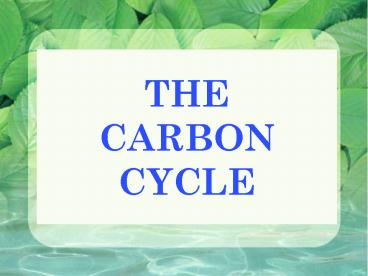THE CARBON CYCLE - PowerPoint PPT Presentation
Title:
THE CARBON CYCLE
Description:
THE CARBON CYCLE THE CARBON CYCLE The movement of carbon, in its many forms, between the biosphere, atmosphere, oceans, and geosphere is described by the carbon cycle. – PowerPoint PPT presentation
Number of Views:136
Avg rating:3.0/5.0
Title: THE CARBON CYCLE
1
THE CARBON CYCLE
2
THE CARBON CYCLE
- The movement of carbon, in its many forms,
between the biosphere, atmosphere, oceans, and
geosphere is described by the carbon cycle. - In the cycle there are various sinks, or stores,
of carbon and processes by which the various
sinks exchange carbon. - These processes of exchange include respiration,
burning, combustion, decomposition, erosion, etc.
3
THE CARBON CYCLE
- Over 300 million years ago (Carboniferous
Period), large amounts of carbon accumulated in
carbon sinks as coal, peat, oils and natural gas.
4
THE CARBON CYCLE
- Coal, peat, and natural gas are fossil fuels. It
took millions of years to make these fuels, but
we are burning them all up in a few hundred
years.
5
THE CARBON CYCLE
- We are all familiar with how the atmosphere and
vegetation exchange carbon (photosynthesis and
respiration). - Plants absorb CO2 from the atmosphere during
photosynthesis, also called primary production,
and release O2 back into the atmosphere.
6
CO2
CO2
7
- Another major exchange of CO2 occurs between the
oceans and the atmosphere. - The dissolved CO2 in the oceans is used by marine
biota in photosynthesis. - The ocean is the largest sink of Carbon Dioxide.
CO2
8
THE CARBON CYCLE
- Photosynthesis producers take in CO2 from
atmosphere. - Respiration aerobic organisms release CO2 into
atmosphere. - Decay as a result of decay CO2 released into
atmosphere. - Combustion Burning of fossil fuels release CO2
into atmosphere.
9
- The uptake and return of CO2 are not in balance
- The carbon dioxide content of the atmosphere is
gradually and steadily increasing. - The increase in CO2 probably began with the start
of the industrial revolution. - Samples of air trapped over the centuries in the
glacial ice of Greenland showed no change in CO2
content until 300 years ago.
10
THE CARBON CYCLE
- Since measurements of atmospheric CO2 began late
in the nineteenth century, its concentration has
risen over 20. - This increase is surely caused by human
activities - burning fossil fuels (coal, oil, natural gas)
returns carbon to the atmosphere, carbon that has
been locked within the earth for millions of
years. - clearing and burning of forests, especially in
the tropics. In recent decades, large areas of
the Amazon rain forest have been cleared for
agriculture and cattle grazing.
11
Human Activities Increasing Carbon Dioxide in the
Atmosphere
CO2
CO2
12
The Complete Carbon Cycle
CO2
CO2
CO2
CO2
CO2
CO2
13
THE GREENHOUSE EFFECT GLOBAL WARMING
- Despite these "sinks" for our greatly increased
CO2 production, the concentration of atmospheric
CO2 continues to rise? Should we be worried? - Carbon dioxide is transparent to light but rather
opaque (not clear) to heat rays. - Therefore, CO2 in the atmosphere slows the
radiation of heat from the earth back into space
the "greenhouse effect".
14
GLOBAL WARMING
- Has the increase in carbon dioxide led to global
warming? - Average temperatures do seem to have increased
slightly (0.6C) in the last century. - Some evidence comes from
- Careful monitoring of both ocean and land
temperatures.
15
MORE EVIDENCE
- -Many glaciers and ice sheets are receding.
- -Woody shrubs are now growing in areas of
northern Alaska that 50 years ago were barren
tundra. - -Many angiosperms in temperate climates are
flowering earlier in the spring than they used
to. - -Many species of birds and butterflies are moving
north and breeding earlier in the spring.
- Many glaciers and ice sheets are receding.
- -Woody shrubs are now growing in areas of
northern Alaska that 50 years ago were barren
tundra. - -Many angiosperms in temperate climates are
flowering earlier in the spring than they used
to. - -Many species of birds and butterflies are moving
north and breeding earlier in the spring.
16
GLOBAL WARMING
- Will continued increase in carbon dioxide lead to
more global warming and, if so, how much? - At this point, the answer depends on what
assumptions you plug into your computer models. - But as the different models have been improved,
they seem to be converging on a consensus - a doubling of the CO2 concentration (expected by
the end of this century) will cause the earth to
warm somewhere in the range of 2.53.5C.
17
Assignment
- On page 35 of your booklet there are 5 questions.
- In groups answer these questions on chart paper
and be prepared to present your groups answers
to the class.































